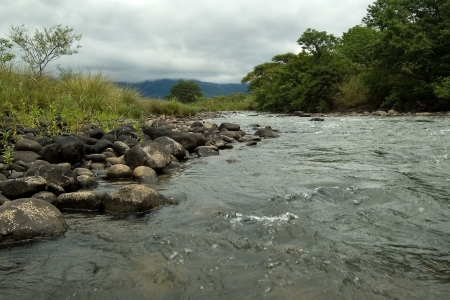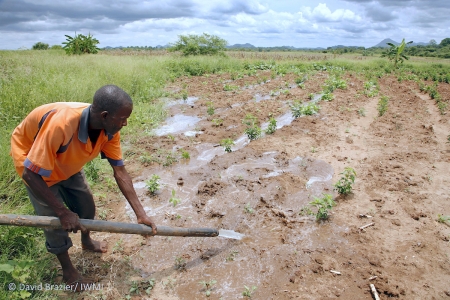Originally published in the ICRISAT Happenings Newsletter.
Watershed interventions have led to 1-2.5 meters higher groundwater levels, providing lifesaving irrigation to the farmers. This was achieved in a challenging environment in two villages in the drylands of Andhra Pradesh, India, which were facing a change in rainfall for the last five years. The steady monsoon showers were turning into sporadic heavy spells resulting in flooding, followed by dry spells that ruined crops. More than half the land lay fallow, until watershed activities were taken up by a Corporate Social Responsibility (CSR) project.

Currently, the recharged rainwater is providing lifesaving irrigation to nearly 410 ha of cultivable area in both the watersheds villages and about three irrigations for about 137 ha of millets or short-duration vegetable crops during the post-rainy season. In 2020-21, a total of 121,500 m3 of rainwater was harvested through 24,150 m3 additional storage capacity that was created to meet crop needs during critical growth stages and to irrigate the post-rainy crops. Improved high-yielding and drought-tolerant crop varieties were introduced to farmers and crop diversification is being advocated.

The CSR initiative of UltraTech in partnership with ICRISAT is reviving livelihoods of more than 500 households in two villages. Water scarcity, low soil fertility, unemployment of landless labor and low agricultural productivity are some of the issues that the project is addressing in Patnikota village in Kurnool district and Ayyavaripalli village in Anantapur district of Andhra Pradesh State.

About the watershed
The upstream village, Patnikota, has a population of 2,700 and 630 households. Castor, cotton, pigeonpea, black gram and green gram crops are rain-fed, while sweet orange, papaya and pomegranate are irrigated. The watershed area in the village is around 3,500 ha of which 40% is arable and the rest either is wastelands or used for non-agricultural purposes. Of the total agricultural area, 50% is rain-fed and 50% is irrigated.
The downstream village, Ayyavaripalli, has a population of 1,000 residents and 250 households. Pigeonpea, cotton and black gram crops are rain-fed areas, while paddy and groundnut are irrigated. The watershed area is around 2,750 ha of which 70% is cultivated and the rest is wastelands or used for non-agricultural purposes. Of the total agricultural area, 50% is rain-fed and 50% irrigated. Activities in this village focus on productivity enhancement demonstrations and reviving existing water harvesting structures.
Watershed interventions from 2019 to 2021
Water harvesting: Both the villages had severe problems with the runoff from the watershed and the team identified locations for building watershed structures.
In Patnikota, five sunken pits created a capacity of 1,200 m3 capacity and harvested 15,015 m3 of rainwater and two percolation tanks having a capacity of 5,000 m3 harvested 41,568 m3 of rainwater.
In Ayyavaripalli, desilting of an existing check dam created a capacity of 2,040 m3 and harvested 19,380 m3 of rainwater. Two percolation tanks that have been desilted recently created a capacity of 6,900 m3 and a total of 45,616 m3 of rainwater was harvested.
The rainwater harvested through groundwater storage is utilized for drinking and supplemental irrigation during the Rabi (post-rainy) season.
Soil health mapping and test based fertilizer recommendations: Soil samples collected from individual farmer fields were analyzed at ICRISAT's soil laboratory. Based on the soil test results, fertilizer recommendation (Urea, DAP, Potash and Zinc) for major crops such as castor, pigeonpea, cotton, groundnut, paddy, pulses and vegetables were given to all individual farmers who had given a sample of their soils for analysis and issued a soil health card.
It has been observed that soil in the entire watershed was alkaline. Zinc, iron, sulfur, organic carbon and phosphorus deficiencies were 71%, 29%, 67%, 38% and 29% respectively. No deficiency of potash, calcium, magnesium, copper, and manganese was observed. The village-level fertilizer recommendation was announced on wall writings at gathering points where farmers meet daily. Farmers' meetings were conducted to share the soil health information and to discuss the fertilizer recommendations. Soil health cards were distributed to the farmers at an event organized by UltraTech Cements.
Improved crop cultivars: Improved crop cultivars of pigeonpea, castor and black gram were supplied to farmers in the watershed. As much as 850 kg of pigeonpea seed (ICPL 87119 and ICPL 8864) was provided for cultivation on 68 ha; 320 kg of hybrid castor seed for 64 ha; and 250 kg of black gram seed for 25 ha in both the villages. About 125 farmers have received improved seeds during the 2019 rainy season (kharif) to cultivate 150 ha and 100 farmers have received improved seed to cultivate on 63 ha during kharif 2020.
Eco-friendly pest management: Farmers have been educated on pest management strategies and the use of eco-friendly options such as yellow sticky traps, pheromone traps, neem oil and benzoate applications.

Creating awareness through field days: Farmers from the watershed were educated about the various methods of cultivation, best agricultural practices, soil and water conservation, crop demonstrations and an exposure visit to ICRISAT by 42 famers further helped enhance their knowledge. An exposure visit for 25 farmers from the Patnikota watershed to the RECL-ICRISAT watershed in Kurnool district was also conducted.
Income generation through millet products: Thirty women were trained in baking millet-based foods for a week. Trainees were supported with all materials required for a month and were oriented on quality, hygiene, safety and taste aspects. The success of this initiative prompted a three-day training program on millet based baking and cooking conducted by ICRISAT's Food and Housing Services. About 40 women attended the training.
Kitchen gardening: Kitchen garden kits (nine vegetable crop seeds: Amaranths, spinach, tomato, okra, beans, eggplant, bottle gourd, ridge gourd and bitter gourd) were given to 150 households. It is estimated that every household consumes 6 kg of different vegetables every week, saving at least ₹ 400 per week
Crop-livestock integration: Nearly 20 households in Patnikota have small ruminants ranging from 50-100 per household that subsist on open grazing. In Ayyavaripalli, a majority of the farmers own milch buffaloes. The average milk yield per animal is 5-6 liters per day. Availability of fodder is a major constraint and the dry fodder (paddy straw) costs around ₹ 3,000-8,000 per ton depending upon the season. To address this issue ICRISAT shared 30 kg seed of its landmark forage sorghum hybrid (CSH24MF) for cultivation on 4 ha duringkharif2020, resulting in increased milk yield of 16%.
Authors:
Dr Rajesh Nune, Scientist-Hydrology, IDC, Jemima Mandapati, Senior Officer- Communications and Arun Seshadri, Scientific Officer.













